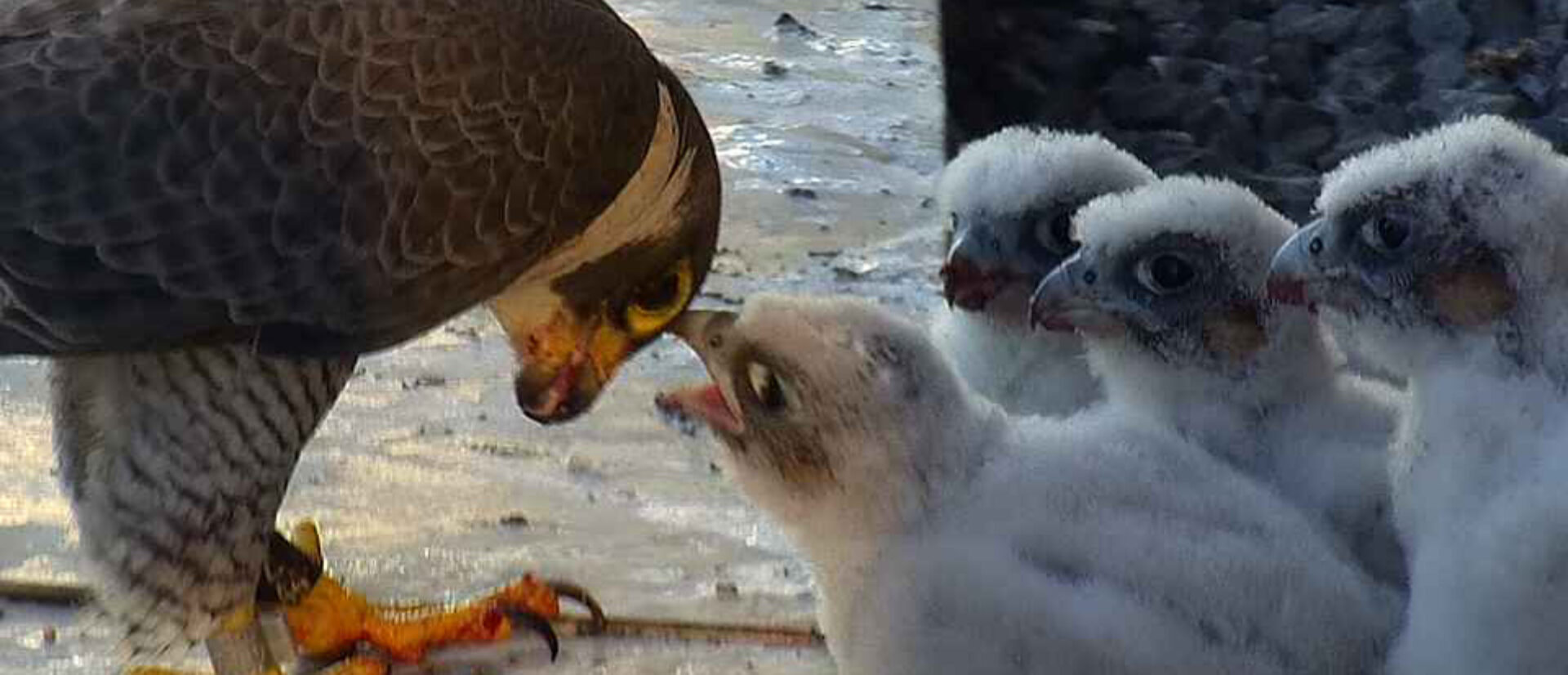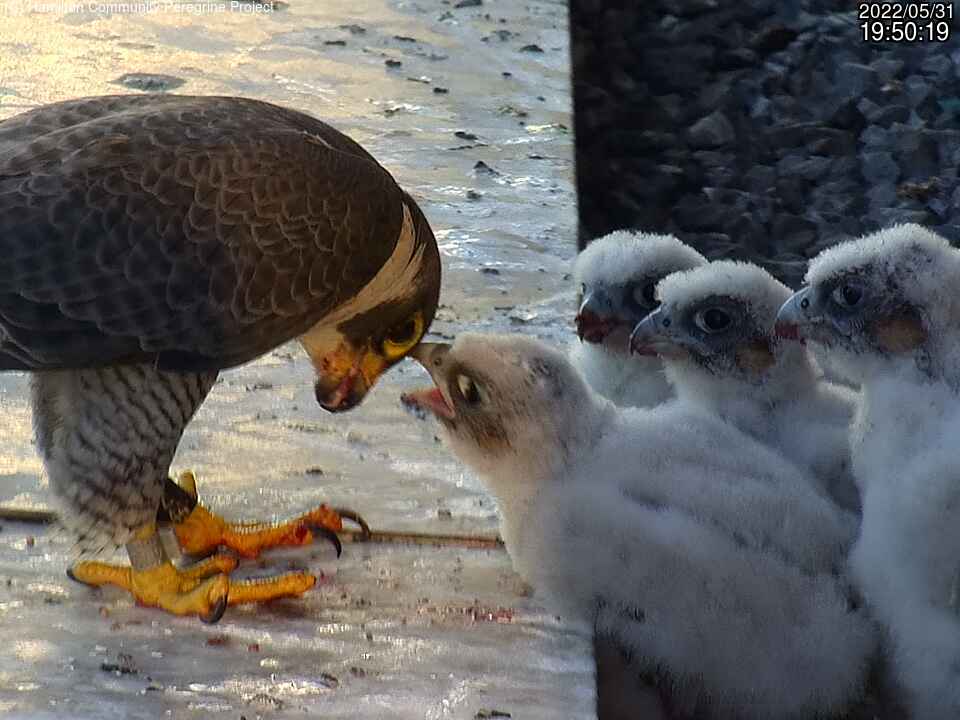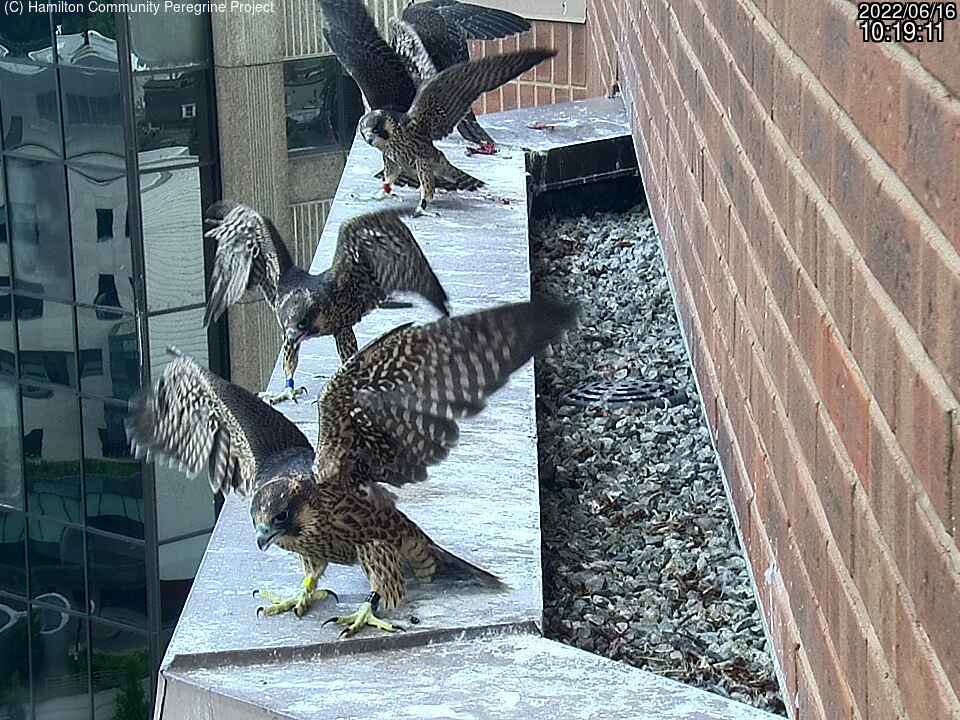Hamilton’s peregrine falcons: A brief history

The beloved birds of prey have been annual visitors to Hamilton’s downtown since the early ‘90s and have captured the imagination of residents ever since.
During a camping trip with my son to Bon Echo Provincial Park in the 1990s we witnessed the release of peregrine falcons high up on a cliff above us. This was my first time seeing a peregrine falcon in the wild. You see, in Canada during the 1950s DDT was widely used to control insects in agriculture. In her book, Silent Spring, biologist and writer Rachel Carson warned of the danger of DDT to the environment, imagining a world without bird noises. Peregrine falcons, like other birds of prey, were severely impacted as they ate birds that, in turn, had eaten insects and plants contaminated with the chemicals. This interfered with their reproductive cycle and caused the developing eggs to have shells so thin that they broke under the weight of the parents during incubation. Peregrine falcons were extirpated in Ontario by the 1960s.
A captive breeding program was established in 1972, leading to the release of approximately 600 young peregrine falcons in Ontario from 1977 until 1996. Releasing juvenile peregrines in the wild made them susceptible to predation and nest boxes were eventually set up in urban areas. Although peregrines naturally nest on high cliffs near water, city architecture, bridges, and quarries provide prime nesting sites and plenty of prey, mainly pigeons. This led to the urbanization of peregrines in Ontario. The success of this program was finally realized with the documentation of an urban peregrine falcon nest site in Ontario in 1986.

It takes a lot of hunting to feed four hungry chicks. 
A young falcon practises its "helicoptering" technique.
In the spring of 1994, the first sighting of a peregrine falcon in Hamilton was noted near the Sheraton Hotel. The Canadian Wildlife Service and the Ontario Ministry of Natural Resources were notified, and in 1995 it was confirmed that a pair of peregrine falcons were nesting on a south-facing ledge of the 18th floor of the Sheraton Hotel.
Peregrines are known for “nest fidelity,” returning to and guarding the nest from season to season. Knowing this, a monitoring effort was set up and coordinated by the Hamilton Naturalists’ Club, other nature groups, and the public. This pair, named Mom and Dad, successfully hatched one chick of their own, as well as fostering two more chicks brought in from an Alberta breeding program, which were placed in the nest by a mountain climber.
After an unsuccessful nesting in 1996, four chicks were fledged the following year. By 1998, the Canadian Peregrine Foundation had installed a video camera and TV monitors were set up in Jackson Square. Once again four chicks successfully fledged.
After the female, Mom, failed to return in the spring of 1999, another female, Toledo (from a nest in Ohio) bonded with Dad and although four eggs were seen on camera, none hatched. Two chicks were brought in from a breeding facility in Quebec and were immediately adopted and fledged normally. Unfortunately, Toledo was killed in a collision with a car in November 2000.
The male renamed Percy, soon paired with Madame X, who arrived in Hamilton in the spring of 2001 from Pennsylvania. Over the next 14 years, Madame X paired up with four different males and fledged 43 chicks. Percy was replaced by Mozart in 2002, successfully raising three chicks. In 2003, soon after banding three chicks, a new male arrived and suddenly Mozart was gone. Newbie and Madam X were together and hatched four eggs over the next two years. By 2006, another new male appeared, later identified as Surge, hatched in Etobicoke in 2002.
Madame X and Surge stayed in Hamilton year-round and successfully raised 27 chicks until 2014. After a first clutch of two eggs failed to hatch, Madame X attempted a second clutch, which also failed to hatch. It was speculated that she was simply too old for breeding as she was turning 15. Falcons typically live about 14 to 16 years.

In early 2015, Surge was found injured and sadly died two months later at the Owl Foundation where he had been taken for treatment. During his absence another male appeared on the scene and seemed to be accepted by Madam X. However, she suddenly disappeared and was replaced by a new female. Eventually, these two would be identified as Ossie, hatched in Etobicoke in 2012, and Lily, hatched in 2010 in Michigan. This new pair remained together until 2021, resulting in eight chicks successfully fledged. In early May, around the time of hatching, a new male was observed at the nest. Ossie mysteriously disappeared, most likely losing a territorial battle with the new male, identified as Judson, fledged from Buffalo, N.Y. in 2018. Unfortunately, although Lily appeared to accept this newcomer, she abandoned her clutch and there were no chicks this year.
In January 2022, Lily passed away after being rescued from the ground in downtown Hamilton. Surprisingly, that same day a new female appeared, later identified as McKeever, hatched in 2019 on the Ambassador Bridge in Windsor. Over the next two months, a variety of juvenile and adult peregrine falcons were seen on camera visiting the nest, but eventually, it was Judson and McKeever who mated and on May 7, the first of four eggs hatched.
Banding on May 27, 2022, revealed four healthy chicks, two males (Dundurn and Balfour) and two females (Wynnstay and Auchmar). Traditionally, the chicks have been named after significant local landmarks and this year it was historical grand mansions in the city. Although all four eventually fledged and have since left the Hamilton area to begin their own journey, the initial flights had volunteers and coordinators quite busy with four birds in the air. This year saw two rescues, both for Auchmar! She soon took a strong flight joining her siblings learning to fly, soar and talon touch, an exercise used to develop their skills needed to hunt prey.
Peregrine falcons have made a comeback in Ontario, moving from endangered in 1973, to species at risk in 2006, and finally in 2013, to species of “special concern." Peregrines may become threatened or endangered due to a combination of threats that face many other species. Although the use of DDT has been banned, other chemicals continue to pose a risk to birds of prey. This year, Dr. Kim Fernie, senior research scientist with Environment Canada, was present at the banding of the four chicks to take blood samples. Fernie and her team are conducting research on the effects of contaminants of concern on birds and other wildlife species. They include fluorinated chemicals (PFASs), which are used in waterproofing clothing and non-stick cookware, and are dangerous to health and the environment.

Also, as urban populations expand, young peregrines face many threats, including colliding with buildings, often with highly reflective or mirrored glass. Busy street traffic below the nest ledge can be deadly if an early flight goes wrong.
Over the years, our Hamilton peregrines have benefited from an active Falcon Watch program, with a total of 23 chicks saved in triumphant rescues. Peregrine falcons usually take to the air at around 40 days of age. Volunteers equipped with binoculars and walkie-talkies take shifts to monitor them during these early days, prepared to rescue one if needed. As an active volunteer, I have found this to be a most rewarding experience and a delight to watch the chicks lose their white downy feathers for the beautiful rich brown and cream of a juvenile peregrine falcon. To observe them as they prepare for that first flight, jumping up on the ledge stretching their wings and “helicoptering” can be quite exciting and heart stopping!
Incidentally, in an online public poll conducted by Bird Friendly Hamilton Burlington last year, the peregrine falcon was voted as Hamilton’s City Bird. The group is working on getting official recognition from Hamilton city hall.
The Hamilton Community Peregrine Project is a non-profit dependent on volunteers and donations. Falcon Watch is always looking for volunteers – no experience required. Orientation and training are available each spring. Financial contributions fund the hiring of Falcon Watch coordinators, equipment rentals, and maintenance and upgrades of computer and camera equipment. If you wish to donate or volunteer, please visit falcons.hamiltonnature.org.












